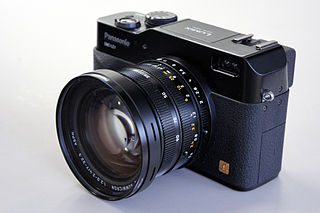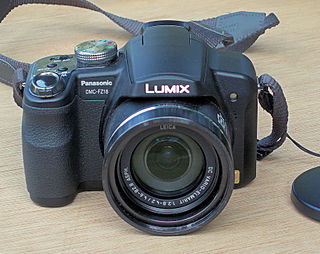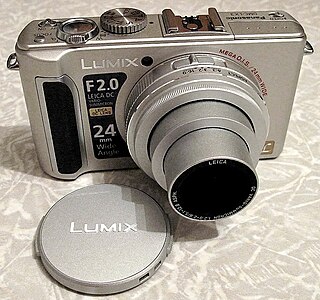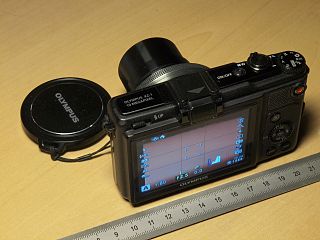
A digital camera, also called a digicam, is a camera that captures photographs in digital memory. Most cameras produced today are digital, largely replacing those that capture images on photographic film or film stock. Digital cameras are now widely incorporated into mobile devices like smartphones with the same or more capabilities and features of dedicated cameras. High-end, high-definition dedicated cameras are still commonly used by professionals and those who desire to take higher-quality photographs.

A digital single-lens reflex camera is a digital camera that combines the optics and mechanisms of a single-lens reflex camera with a solid-state image sensor and digitally records the images from the sensor.
The Leica Digilux 1 is a digital camera developed in partnership with Panasonic, which was released in 2002, roughly the same time as the Canon PowerShot G2 and the Nikon 2000. It is the second of Leica's digital offerings. Where the original Digilux was developed in partnership with Fuji Camera, the Digilux 1 was developed jointly with Panasonic; Leica is responsible for optics, while Panasonic designs the camera electronics. According to Leica, this allows both companies to design cameras that creates a harmonious matching of lens to sensor to produce color and contrast to Leica standards.

Lumix is Panasonic's brand of digital cameras, ranging from pocket point-and-shoot models to digital SLRs.

The Micro Four Thirds system is a standard released by Olympus Imaging Corporation and Panasonic in 2008, for the design and development of mirrorless interchangeable lens digital cameras, camcorders and lenses. Camera bodies are available from Blackmagic, DJI, JVC, Kodak, Olympus, OM System, Panasonic, Sharp, Logitech Mevo and Xiaomi. MFT lenses are produced by Cosina Voigtländer, Kowa, Kodak, Mitakon, Olympus, Panasonic, Samyang, Sharp, Sigma, SLR Magic, Tamron, Tokina, TTArtisan, Veydra, Xiaomi, Laowa, Yongnuo, Zonlai, Lensbaby, Venus Optics and 7artisans amongst others.

The Panasonic Lumix DMC-FZ18 is a superzoom bridge digital camera that features:

The Panasonic Lumix DMC-G1 was the first digital mirrorless interchangeable-lens camera (MILC) adhering to the Micro Four Thirds system design standard. The G1 camera is similar to the larger Four Thirds system format DSLR cameras, but replaces the complex optical path needed for the optical viewfinder with an electronic viewfinder EVF displaying a live view image directly from the sensor. Eliminating the mirror box and optical viewfinder allows for smaller and lighter camera bodies, while the less complex optical path also allows for smaller, lighter lens designs.

The Panasonic Lumix DMC-GH1 is a digital mirrorless interchangeable lens camera adhering to the Olympus and Panasonic developed Micro Four Thirds System (MFT) system design standard. Panasonic classified the GH1 as a hybrid stills/video camera and the GH1 was introduced and marketed as a higher end camera than Panasonic's first MFT camera, the stills only, non-video capable Lumix DMC-G1.

The Panasonic Lumix DMC-LX3, or LX3, is a high-end compact "point and shoot" camera launched by Panasonic in late 2008 to succeed the Lumix LX2.

A mirrorless camera is a digital camera which, in contrast to DSLRs, does not use a mirror in order to ensure that the image presented to the photographer through the viewfinder is identical to that taken by the camera. They have come to replace DSLRs, which have historically dominated interchangeable lens cameras. Other terms include electronic viewfinder interchangeable lens (EVIL) and compact system camera (CSC).

The Canon PowerShot S95 is a high-end 10.0-megapixel compact digital camera announced and released in 2010. It was designed as the successor to the Canon PowerShot S90 in the S series of the Canon PowerShot line of cameras.

The Panasonic Lumix DMC-GH2 is a digital camera with HD video recording capability that is part of the Micro Four Thirds system. Though commonly referred to as a DSLR camera, it has no mirror or optical viewfinder, but has instead both a fold-out LCD screen and a electronic viewfinder.

The Olympus XZ-1 is a high-end 10.0 megapixel compact digital camera announced and released in January 2011. Its key features are a fast f/1.8-2.5 i.Zuiko Digital lens, a built in imager shift image stabilizer and Olympus' 6 Art Filters that are also present in the E-PEN series.

The Panasonic Lumix DMC-G2 is a digital mirrorless interchangeable lens camera that adheres to the Micro Four Thirds System (MFT) design standard developed by Olympus and Panasonic. It was announced by Panasonic in March 2010 along with the Lumix DMC-G10. The G2 was introduced as the successor to the Lumix DMC-G1 camera, with upgrades such as 720p high-definition video recording capability in AVCHD Lite and Motion JPEG formats.

The Panasonic Lumix DMC-LX7, or LX7, is a high-end compact "point and shoot" camera launched by Panasonic in 2012 to succeed the LX5.
This page is based on this
Wikipedia article Text is available under the
CC BY-SA 4.0 license; additional terms may apply.
Images, videos and audio are available under their respective licenses.














